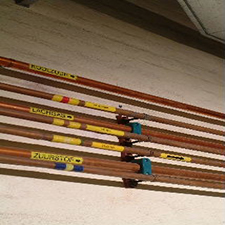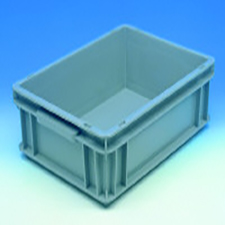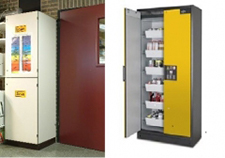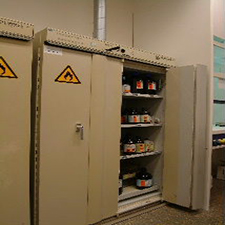Page content
- Government guidelines
- General storage requirements
- Labelling
- High-risk combinations of dangerous substances
- The use of drip trays
- The working stock
- Stock up to 150 or 250 kg or litres
- Explosive substances and radioactive substances
- Fire protection cabinets
- Several types of cabinets
- Stock of more than 250 kg or litres
Government guidelines

There are regulations available for the storage of dangerous substances. The most important ones are listed below. A complete list of the storage requirements can be found in the PGS 15 guideline, which describes the storage of packed dangerous substances. The abbreviation PGS stands for Publicatiereeks Gevaarlijke Stoffen (series of publications on dangerous substances). The old CPR 15-1 directive has been replaced by PGS 15. Ask your OHS advisor about this guideline and the internal policy pursued at your UMC.
General storage requirements
The following requirements apply to all forms of storage:
- Affix the mandatory hazard symbols and safety signs to the doors of rooms intended for storage and to the doors of storage cabinets for dangerous substances;
- Lock the generally accessible cabinets and work areas containing dangerous substances during the absence of staff;
- Always store (extremely) toxic substances in a sealed box with a skull pictogram on it. Place this box in a vented room;
- Make sure that glass bottles for immediate use have a maximum capacity of 2.5 litres;
- Never place glass bottles with dangerous contents at a height above 1.2 metres;
- Empty packaging that has not been cleaned should be treated in the same way as full containers and bottles.
Labelling

Observe the following regulations in your area for the labelling of reservoirs, pipes, and fill and tap points for dangerous substances:
- Affix the corresponding hazard pictogram by way of warning;
- If appropriate, add the name or formula of the substance;
- Specify the direction of flow of the fluid on pipes;
- Specify the contents on a reservoir.
High-risk combinations of dangerous substances
Certain dangerous substances can react with each other, which can lead to dangerous gases, vapours or situations. Below you can see which substances should not be stored together. Hazard categories that should not be stored together are marked with an X.
The use of drip trays

The use of drip trays is subject to the following regulations:
- Place dangerous substances in separate drip trays arranged by hazard classification. In the case of flammable and explosive substances, the drip tray must be capable of collecting the entire contents. For other substances, the drip tray must be able to collect the contents of the largest packaging plus 10% of the contents of the other packaging;
- Place acids and bases in separate drip trays;
- Check that the material of the drip tray is resistant to the dangerous substance;
A washing-up bowl is not suitable as a drip tray.
The working stock
The quantity of dangerous substances required to carry out the daily work is the working stock. This quantity may remain in the workplace. Hold your staff to the following instructions:
- Always use the smallest possible volume;
- Never leave more than 1 kg or litre of flammable substances per m free in the work area;
Never allow more than 25 kg or litres of dangerous substances to be present in the entire work area without a storage facility. Store such quantities in suitable storage cabinets. Also remember the waste of dangerous substances and the waste drums present.
Stock up to 150 or 250 kg or litres

Departments store buffer stocks in storage cabinets. This makes it possible to replenish the working stock of one or more departments without any problems. Depending on the type of cabinet, a maximum quantity can be stored in a separate cabinet. A structural cabinet may contain a maximum of 250 kg or litres. Check and clean up the stock annually and dispose of any excess material. Depending on the hazard category, you can choose from the individual cabinets listed below
Explosive substances and radioactive substances
Explosive substances and radioactive substances are described in specific guidelines and must not be stored in the same storage facility as the PGS 15 substances. Ask your OHS advisor about these guidelines and the internal regulations applied at your UMC.
Fire protection cabinets

The PGS 15 also contains a number of specific requirements for fire protection cabinets. These requirements depend on the fire resistance of the cabinet. The fire resistance of the cabinet determines how many litres can be stored in the cabinet and the maximum number of cabinets that can be placed in the room. Ask your OHS advisor about the guideline. In general, take the following into account:
- Connect the cabinet to a separate mechanical extraction system (not the air conditioning system);
- Do not work in a work area with an increased fire hazard (no naked flames) when fire protection cabinets are placed against each other;
- Do not use fire protection cabinets to shield rooms;
- Do not place fire protection cabinets within one metre of doors and emergency exits;
- Do not place fire protection cabinets in cellars, stairwells or corridors that also serve as escape routes.
Several types of cabinets
The structural cabinet
A structural cabinet is a structural facility and must be tested in combination with the PGS 15 guideline. Please contact your OHS advisor.
The standard storage cabinet
A separate cabinet with doors. No ventilation or extra fire resistance present. It can be used to store dry chemicals, with the exception of: toxic, flammable, explosive, oxidising and water-reactive substances.
The chemical cabinet
A cabinet with light extraction but no fire resistance. For example, the bottom cabinets of fume cupboards that are connected to the extraction of the fume cupboard. This can be used to store irritants and/or harmful substances as well as acids and lyes, provided they are placed in separate drip trays.
The fire protection cabinet
A cabinet with a minimum fire resistance of 60 minutes. The cabinet is fitted with extraction. The cabinet can be used to store extremely flammable, highly flammable and explosive substances. Depending on the standard of the cabinet, there are more storage options.
The poison cabinet
A cabinet that can and must be closed. A poison cabinet may be located in a well-vented room, a fire protection cabinet or in a refrigerator. A poison cabinet is used to store substances that fit into the category of toxic, very toxic.
The explosion-proof refrigerator/freezer
A refrigerator or freezer without an igniter inside the cabinet. For example, the light in the cabinet is missing or is explosion-proof. This cabinet is used to store extremely flammable, highly flammable and explosive substances that must remain cold or frozen. Never unscrew the light in a household refrigerator to make it 'explosion-proof'!
The standard refrigerator
A normal commercial refrigerator. Only non-toxic substances that do require cooling may be stored in this refrigerator.
Stock of more than 250 kg or litres
Storage of more than 250 kg or litres can be found, for example, at pharmacies, central warehouses and waste management. Such large stocks are stored in safes, storage buildings and drum storage sites. A large number of strict requirements are set for these storage facilities. Your OHS advisor can provide you with all the necessary information.
